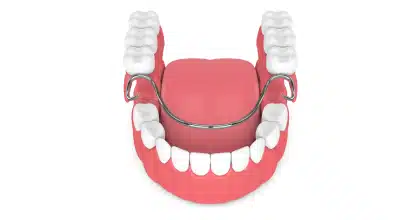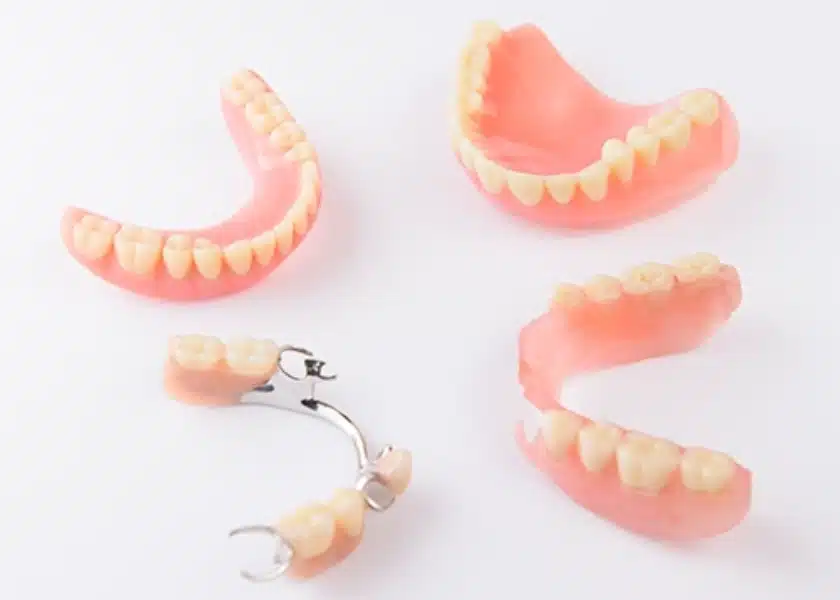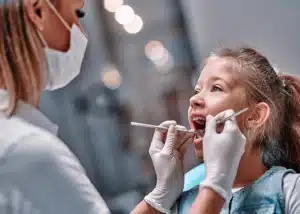Dealing with missing teeth is not just a cosmetic concern but can also lead to functional issues and dental complications. One viable solution for addressing this problem is the use of removable partial dentures. In this comprehensive guide, we will look into the key aspects of partial dentures, exploring their types, benefits, the procedure involved in getting them, associated costs, insurance coverage, and their longevity.
What Are Removable Partial Dentures?
Partial dentures serve as a solution to replace one or more missing teeth and offer both functional and aesthetic benefits. These dentures are removable and designed to blend seamlessly with the natural teeth. Unlike dental implants, partial dentures are not permanent fixtures but provide an effective and affordable option for those with missing teeth.

Partial Dentures vs. Dental Implants
Distinguishing between partial dentures and dental implants is crucial in making an informed decision. While dental implants are considered the optimal choice due to their natural feel and permanence, partial dentures are removable. Factors such as health issues, insufficient bone structure, medication compatibility, or budget constraints may lead individuals to opt for partial dentures over implants.

Types of Partial Dentures
Once you and your prosthodontist agree that a Removable Partial Denture is the way to go, it’s time to explore the available choices.
There are three primary types of Partial Removable Dentures:
Cast Metal Removable Partial Dentures
- These are the most common and durable partials.
- They utilize metal clasps or precision attachments to connect to your natural teeth, featuring a metal base made of cobalt-chromium alloy.
- The choice between metal clasps and precision attachments involves aesthetics. Precision attachments, while less noticeable, may be pricier but offer a more natural look.
- Cast Metal Removable Partial Dentures serve as a long-lasting and reliable permanent solution.
Acrylic Clasp Removable Partial Dentures (Dental Flippers)
- Also known as “dental flippers,” these dentures are made of pink material resting on the mouth tissue.
- Considered weaker and more prone to breakage, they are typically recommended as a temporary solution until your Cast Metal Removable Partial Dentures are ready.
- Dental flippers are the least expensive type but may lack the comfort of the others due to the thickness of the acrylic base.
Flexible Partial Dentures
- A suitable temporary alternative for individuals allergic to cast metal or acrylic.
- These dentures offer comfort and aesthetic appeal as they are made from a thin, flexible plastic material.
- While more expensive than other types and with a shorter lifespan, Flexible Partial Dentures provide a viable option for restoring missing teeth.
Each type has advantages and considerations, so discussing your preferences and specific needs with your prosthodontist will help determine the best fit for you.
Who Might Benefit From Partial Dentures?
Partial dentures are particularly suitable for individuals with a few missing teeth or those with most of their natural teeth in good condition. Preserving natural teeth is emphasized, as partial dentures utilize them as anchors, ensuring better retention during activities like chewing.
Procedure for Getting Partial Dentures
The process of obtaining partial dentures involves several steps:
- Comprehensive Exam: A thorough examination assesses the condition of the patient’s mouth, identifying any issues that need addressing before fabricating the dentures.
- Tooth Fragment Removal Surgery: If necessary, minor surgical procedures may be performed to eliminate any remaining tooth fragments or bony areas, ensuring a smooth foundation for the dentures.
- Fabrication: Custom impressions and a wax rim try-in help create a precise fit for the partial dentures, ensuring comfort and functionality.
- Fitting and Adjustments: Try-on appointments verify the shape, size, and color of the teeth, leading to the final delivery. Post-delivery adjustments are common to address any sore spots.
What is the cost of removing partial dentures?
The cost of partial dentures varies based on factors such as the provider’s experience and the quality of the laboratory. Generally ranging between $1,000 and $4,000, partial dentures offer a more budget-friendly option compared to dental implants.
Does Insurance Cover the Cost of Partial Dentures?
Many insurance plans cover at least a section of the cost of partial dentures. However, coverage varies, with plans often including co-pays, deductibles, and yearly limits. It is advisable to contact the dental insurance plan beforehand to understand the financial implications.
Benefits of Removable Partial Dentures
Partial dentures provide several advantages, including aesthetic enhancement, functional restoration, improved speech, prevention of tooth shifting, affordability, and a non-invasive process. These benefits make them a popular choice for individuals seeking an effective and accessible solution for missing teeth.
How Long Do Removable Partial Dentures Last?
The lifespan of removable partial dentures hinges on factors such as materials used, oral hygiene practices, and changes in oral health. Well-crafted and well-maintained dentures can typically last 5 to 10 years or more. Signs of wear, deterioration, cracks, chips, or changes in fit may indicate the need for replacement or repair.
What Happens After the Removable Partial Denture is Ready to Use?
Once your removable denture is ready for use, expect restored confidence in your smile and improved chewing. Initial discomfort is normal during the adaptation period, as new dentures might feel odd or loose until your mouth adjusts. Patients may experience some irritation, which typically diminishes with time. Regular checkups are essential, and adjustments may be needed as your mouth changes with age to ensure proper fit and prevent potential issues.
How do you take care of your removable dentures?
Caring for removable dentures is akin to caring for natural teeth.
- Floss and brush them diligently.
- Attend regular consultations with your prosthodontist.
- Exercise caution while chewing
- Avoid certain foods, as the teeth in Removable Partial Dentures are not as resilient as natural or fixed dentures.
Aftercare and Maintenance
- Consume soft foods and chew slowly.
- Slowly eat other food items to get used to dentures.
- Don’t consume hard items like ice, and steer clear of gum or candies.
Conclusion
Partial dentures play a key role in restoring both the form and function of a smile for individuals with missing teeth. With the flexibility of being removable and the ability to preserve natural teeth, they offer a practical solution. If you’re considering partial dentures, consult with your dentist to determine the most suitable type and understand the overall procedure and costs involved.
If you are missing a tooth and need replacement, contact us at Diamond Dental, Bellingham, WA. Neglecting to replace a missing tooth can lead to various adverse effects, such as the shifting of adjacent teeth, facial sagging that can make you appear older than your age, and challenges in eating and speaking. Schedule an appointment with us today for the replacement of removable partial dentures. Alternatively, New Patients can call us at (360) 516-4610, while all other callers can reach us at (360) 734-1999.
FAQs
Clean with a soft toothbrush and denture cleaner or mild soap. Avoid abrasive toothpaste.
Yes, they restore chewing functions, allowing a variety of foods. Start with softer foods initially.
Initially, some discomfort may occur, but adjustments enhance comfort.
Generally, remove during sleep to give your gums and jaw a rest. Follow your dentist’s guidance.
Contact your dentist immediately. Attempting home repairs may lead to further issues.








